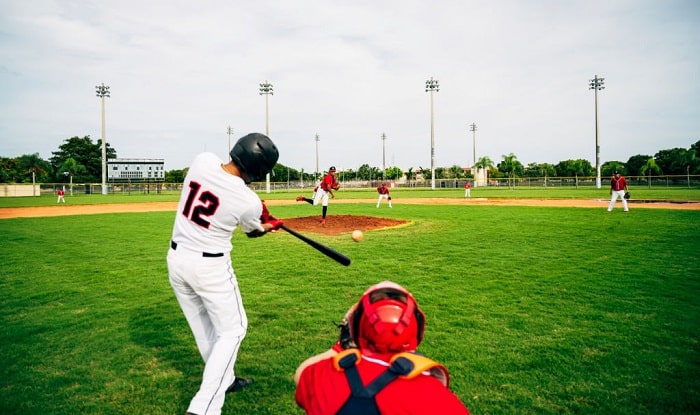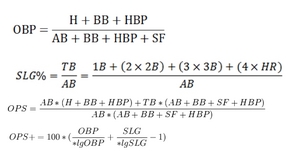There are a lot of terms and abbreviations in baseball. Such as RBI, SAC, HBP, BB, K. The list goes on and on. One of them is OPS, which isn’t a popular or well talked about stat.
However, OPS is a great stat for all-around offense, and a good stat category to use in Fantasy Baseball. You might see OPS at a baseball game when showing a player’s stats. Or on the back of baseball cards.
What is OPS in baseball? What does OPS mean?
OPS in baseball stands for On-Base Plus Slugging. OPS combines On-Base percentage and Slugging percentage.
It is meant to calculate a hitter’s ability to reach base along with how well they can hit for average and power.
The reason OPS is becoming more widely known and used is what the formula combines, on base percentage plus slugging percentage.
Contents
OPS Importance
Instead of a hit counting as just a hit and increasing batting average, OPS includes extra-base hits, along with other ways of reaching base. OPS takes into account a player’s plate appearances, and then the result of their at bat.
The On-Base portion of OPS shows how frequently a batter reaches base.
That part is the players on base percentage. A batter can reach base safely via hits, walks, and hit by pitches. Errors are not factored in.
The Slugging percentage portion of the calculation equates the total number of bases a player reaches for each at bat.
Unlike On-Base percentage, Slugging percentage only includes hits. Walks and Hit By Pitches are not part of the equation.
Using a player’s slugging percentage on top of the player’s on-base percentage is great for power hitters because it includes extra-base hits. Like doubles, triples, and home runs.
The On-Base percentage is also beneficial for the hitters that tend to get walked a bunch. This gives them statistical credit for reaching base. This helps increase a player’s on base percentage.
By combining both On-Base and Slugging, you get a true number of how often a batter is not only on base, but how well they are hitting when they reach base.
What is a good OPS in baseball?
The numbers may seem strange to really understand what is a good OPS in baseball or what is not a good OPS.
You first have to understand what a good On-Base percentage is and what is a good slugging percentage.
A good On-Base percentage is slightly above what a good batting average is. A player’s on-base percentage is a good indicator of taking good at-bats or putting the ball in play.
We all know an above-average batting average is about .300 and up. For the On-Base percentage, particularly in Major League Baseball, the average is about .320. Good is .360, and anything above that is great.
For Slugging percentage, .450 is about the league average, whereas .500 slugging is good, .550 and up is outstanding.
Let’s put those numbers together to see what a good OPS in baseball is. A good OPS in baseball is .7667 and above. The average OPS is in the .7000 to .7666 range. The chart below is a good representation of the scale of bad to great with OPS.
Players in the .9000 and above range mean they are hitting a lot of home runs and extra-base hits, along with being walked a lot.
They also probably have a good average, close to .300. Truly an all-around great hitter when they are in the .900 OPS range.
Reasons for OPS
Another reason OPS is so good to use is because it eliminates overhyping the pure home run hitter. Some major league players can have a high OPS but not a lot of Homeruns. And that’s totally fine.
Some players hit many home runs but have a very low batting average and rarely walk or reach base. Mainly Power Hitters, their main source of hitting comes from home runs. But not reaching base or getting hits otherwise.
That’s okay in baseball, but that player will have a high slugging percentage, but a low On-Base percentage. Which in turn, will bring down their OPS. Managers want to see players reach base, regardless of how. Striking out and just hitting home runs has its benefits, but also a lot of flaws.
OPS helps understand a player’s offensive performance.
On the flip side, other types of players reach base via a walk and base hits but don’t hit for power.
They will have a high On-Base percentage (which managers really like), but low slugging. A batter’s on-base percentage is important because it shows they have a good eye at the plate and also makes consistent contact.
Low slugging average is okay, not everyone is a power hitter. But knowing someone has a low slugging average helps a manager know where to spot them in the lineup.
Typically, you would want a high on-base percentage player batting in front of a high slugging percentage player. The high OBP player would be scoring runs while the high slg player is the one driving runs.
In Fantasy baseball, a good tip is to look for players with high OPS. That means they are finding ways to reach base and hit for power while doing so.
How do you calculate OPS in baseball?
On-Base plus Slugging. That’s the equation to calculate OPS. But first, we need to get to On-Base percentage and then Slugging percentage, before we combine the two.
On-Base Percentage: Hits + Walks + Hit-By-Pitches / AB + Walks + Hit-By-Pitches + Sacrifices
The equation factors in all possibilities of reaching base divided by the possibilities of what happens to count as an at bat.
To really make it easier and basic, the equation for On-Base Percentage = the number of times on base divided by the number of plate appearances.
For Slugging percentage, it’s a little bit simpler because it’s the total number of bases a player reaches per at-bat.
While batting average calculates by dividing the total number of hits by total number of at bats, slugging percentage does not count all hits as equal. Extra Base hits are worth more.
A single is worth 1, a double is worth 2, triple worth 3, and homerun worth 4. The equation for Slugging Percentage = (1B + 2Bx2 + 3Bx3 + HRx4/AB)
OPS Breakdown by game examples – Example ops formula:
Single Game Batting Examples:
A: Single, Out, Homerun, Single = (1+0+4+1/4) = 1.500 Slugging %
B: Out, Triple, Single, Walk = (0+3+1/3) = 1.333 Slugging %
C: HR, Out, HR, single (4+0+4+1/4) = 2.250 Slugging %
D: Out, Single, Out, Out (0+1+0+0/4) = 0.250 Slugging %
To get our OPS, next we need to combine the On-Base percentages and the Slugging percentages. We will use the same 4 examples from above to get our OPS.
A: Single, Out, Homerun, Single = (1+0+4+1/4) = 1.500 Slugging % and .750 On-Base %
A: 1.500 Slugging % + .750 On-Base % = 2.25 OPS
B: Out, Triple, Single, Walk = (0+3+1/3) = 1.333 Slugging % and .750 On-Base %
B: 1.333 Slugging % + .750 On-Base % = 2.083 OPS
C: HR, Out, HR, single (4+0+4+1/4) = 2.250 Slugging % and .750 On-Base %
C: 2.250 Slugging % + .750 On-Base % = 3.00 OPS
D: Out, Single, Out, Out (0+1+0+0/4) = 0.250 Slugging % and .250 On-Base %
D: .250 Slugging % + .250 On-Base % = 0.50 OPS
Over the course of a regular season, .7667 OPS is the target or goal. Which you can see based on single game examples, would be normal to reach. Anything greater than .900 is outstanding.
Who has the highest OPS in Baseball?
It’s easy to understand that the players with the highest OPS in baseball typically end up being the best all-around hitters. Either in their respective season or all time.
OPS really shows the hitters true ability on offense. That’s because OPS factors hit, types of hits like extra-base hits, powerful hits (such as home runs), walks and hit by-pitches.
All ways to reach base without a fielding error or fielders choice during a plate appearance. Thus, a very good statistic to show a player’s offensive output.
The highest OPS in Baseball of All-Time is Babe Ruth. No surprise there, especially the top 10 below. I’m thankful to have been able to watch Barry Bonds, Mike Trout, Manny Ramirez, and Mark McGwire among the top 10. All of them at some point had a MVP Seasons, and a large part of that was due to a high OPS.
Top 50 list of lifetime OPS leaders in Major League Baseball history, via Baseball Almanac:
*Bold players are current/active players as of 2022
The list proves that .900 and above is outstanding for OPS. And only 8 Major League Baseball players All-Time achieve over 1.000 OPS. Those players hit both for power and average.
Babe Ruth has the highest career OPS but you have to consider the type of pitching he was facing during that era.
Pitchers during Babe Ruth’s era were no where as talented as pitchers are in the modern era, but there is an argument to be made that isn’t Babe Ruth’s fault.
In recent memory, Barry Bonds in 2001 was by far the most powerful OPS leader I’ve ever seen. In the 2001 season, Bonds had an OPS of 1.379!
Is OPS better than batting average?
Throughout baseball history, a player’s batting average has been one of the longest standing and most referred to statistics for offense.
And rightfully so because it’s simple calculation and good measurement. How many times does a batter get a hit compared to at bats?
What is the average number of times a batter gets a hit? It’s a great stat. But OPS can be argued that it’s slightly better. Especially when
In my opinion, both have value. It’s great to know how often a batter gets a hit on average. But there are many ways to analyze a batter’s offensive production.
Hits are the main goal on offense in baseball because that’s the quickest way to score runs yourself. Walks rely heavily on a pitcher not locating. Hits after hits produce runs.
OPS however correlates better to the teams runs because it calculates all ways a batter gets on base, along with where they are on base.
Basically, it counts extra base hits more than batting average does because batting average counts all hits the same. OPS measures each type of hit (single, double, triple, homerun) and other ways of getting on base safely (walks, hit by pitch).
A player’s ops could be very important for some teams. Especially in the major leagues where a baseball player’s performance is over analyzed. Teams may value the ops statistic in baseball more so than others.
A player’s ability to “slug” the ball, which results in increased slugging %, means more than likely they are helping the team score runs. That’s because they are hitting for power, getting extra base hits, and probably driving in runs.
Batting average is great, but sometimes a high batting average could mean lots of base hits. Hits are great, but sometimes base hits don’t lead to runs, not near as much as extra base hits do.
Final Word
OPS means On Base Plus Slugging. On Base plus Slugging or OPS in baseball counts all ways a batter reaches base safely.
Without reaching safely via error or fielders’ choice. OPS is a good measure of a player’s offensive performance.
Many times, players who have had an MVP season have also lead the league in OPS. OPS measure a player’s ability to not only get one base, or get hits, but get extra base hits.
Most of the All-Time Career Leaders in OPS in baseball are in the Hall of Fame.
OPS also counts extra-base hits with more value than all hits being equal like batting average does.
OPS is the equation of On-Base Percentage PLUS Slugging Percentage. Adding both numbers equals OPS.
Using OPS as a stat or focal point on offense is a great indicator of how well a batter is helping produce runs for the team.
Other Popular Articles:
What is a bullpen in baseball?
What is a walkoff in baseball?





